Legomo: Malsamoj inter versioj
| [kontrolita revizio] | [kontrolita revizio] |
| Linio 162: | Linio 162: | ||
{{Ĉefartikolo|Legomĝardeno|Utilĝardeno}} |
{{Ĉefartikolo|Legomĝardeno|Utilĝardeno}} |
||
[[File:AUSAID SOUTH AFRICA (10672860713).jpg|thumb|right|Growing vegetables in South Africa]] |
[[File:AUSAID SOUTH AFRICA (10672860713).jpg|thumb|right|Growing vegetables in South Africa]] |
||
Legomoj estis parto de la homa dieto el [[ekstermemora tempo]]. Kelkaj estas bazaj manĝaĵoj sed plej estas akcesoraj kromaĵoj, kiuj aldonas variecon al manĝaĵoj ties unikajn gustojn kaj samtempe, kaj aldonas ankaŭ nutraĵojn necesaj por la sano. Kelkaj legomoj estas [[Staŭdo|plurjaraj]] sed plej estas [[Unujara planto|unujaraj]] and [[Biennial plant|biennials]], usually harvested within a year of sowing or planting. Whatever system is used for growing crops, cultivation follows a similar pattern; preparation of the soil by loosening it, removing or burying weeds and adding organic manures or fertilisers; sowing seeds or planting young plants; tending the crop while it grows to reduce weed competition, control pests and provide sufficient water; harvesting the crop when it is ready; sorting, storing and marketing the crop or eating it fresh from the ground.<ref name=RHS/> |
|||
Different soil types suit different crops, but in general in temperate climates, sandy soils dry out fast but warm up quickly in the spring and are suitable for early crops, while heavy clays retain moisture better and are more suitable for late season crops. The growing season can be lengthened by the use of [[Horticultural fleece|fleece]], [[Cloche (agriculture)|cloches]], [[plastic mulch]], [[polytunnel]]s and [[greenhouse]]s.<ref name=RHS>{{cite book |title=The Royal Horticultural Society Encyclopedia of Gardening |last1=Brickell |first1=Christopher (ed) |year=1992 |type=Print |publisher=Dorling Kindersley |isbn=978-0-86318-979-1 |pages=303–308}}</ref> In hotter regions, the production of vegetables is constrained by the climate, especially the pattern of rainfall, while in temperate zones, it is constrained by the temperature and day length.<ref name=Field/> |
Different soil types suit different crops, but in general in temperate climates, sandy soils dry out fast but warm up quickly in the spring and are suitable for early crops, while heavy clays retain moisture better and are more suitable for late season crops. The growing season can be lengthened by the use of [[Horticultural fleece|fleece]], [[Cloche (agriculture)|cloches]], [[plastic mulch]], [[polytunnel]]s and [[greenhouse]]s.<ref name=RHS>{{cite book |title=The Royal Horticultural Society Encyclopedia of Gardening |last1=Brickell |first1=Christopher (ed) |year=1992 |type=Print |publisher=Dorling Kindersley |isbn=978-0-86318-979-1 |pages=303–308}}</ref> In hotter regions, the production of vegetables is constrained by the climate, especially the pattern of rainfall, while in temperate zones, it is constrained by the temperature and day length.<ref name=Field/> |
||
Kiel registrite je 11:40, 16 dec. 2015


Legomo estas nutrada kaj kuirarta termino kiu signifas parton de vegetaĵo, kiu estas kutime manĝata de homoj ĉu kiel tuto ĉu kiel parto de la plado, sed ne estas dolĉa frukto, nukso, spico, aŭ greno. La termino legomo ankaŭ signifas la tutan vegetaĵon, kies partoj estas manĝataj. Oni manĝas foliojn (kiel ĉe laktuko), tigojn (ĉe asparago kaj preferinde la plej freŝajn burĝonajn partojn), radikojn (ĉe karotoj), tuberojn (ĉe terpomoj), kaj florojn (brokolo) de diversaj plantoj. Tamen, la termino ankaŭ inkluzivas diversajn nedolĉajn fruktojn, kiel guŝojn (fabojn), tomatojn, avokadojn kaj la molajn semojn de kelkaj plantoj kiel maizo (aludata plej ofte kiel cerealo) kaj pizoj.
Ĉe PIV legomo estas ĉiu manĝebla ĝardena herbo (escepte de sukaj fruktoj kaj de spicaj herboj). Estas plej konataj tipoj la jenaj: folilegomo (ekz. laktuko, plej multaj brasikoj, spinaco), florlegomo (ekz. florbrasiko, brokolo, artiŝoko), fruktolegomo (ekz. kukurbo, tomato), radiklegomo (ekz. karoto), semlegomo (ekz. pizo), ŝoslegomo (ekz. asparago), tiglegomo (ekz. medolbrasiko).
La termino "legomo" estas iome neregula, kaj amplekse difinita per de kuirarta kaj kultura tradicio. Ĝi normale ekskludas aliajn manĝaĵojn derivitajn el plantoj kiaj fruktoj, nuksoj kaj cerealogreno, sed povas kaj ja inkludas semojn kiaj guŝoj aŭ legumoj. En kelkaj lingvoj oni alproksimigas la signifon de legomo al tiu de vegetalo, uzata ĉefe en biologio, kaj ne tiom por manĝo aŭ nutrado.
Priskribo

Legomvendisto estas profesiulo kiu dediĉas sin al vendado de legomoj kaj fruktoj plej ofte en sama vendejo aŭ sekcio de ĉiovendejo. Ĝi estas grava fako en vendejoj de manĝaĵoj, kune kun viando, fiŝo, pano, ovoj, lakto ktp. La termino legomejo povas referenci al ĉia tipo de kampo kie oni kultivas legomojn, sendepende de grando, posedmaniero, laborsistemo ktp. Dum la termino legomĝardeno plej ofte estas uzata por malgrandaj kampoj plej ofte proksime aŭ eĉ tute apude de domo, kiu es povas esti ĉu hejmo de la legomisto (legomproduktanto, kamparano) aŭ domo por laboriloj, stokejo, stalo ktp.). La termino legomujo estas uzata por aludi al telero aŭ alitipa manĝujo kiel bovlo, en kiu oni surtabligas la legomojn, por ties manĝo.
Legomoj estas preferata manĝofako por vegetarismo, kune kun fruktoj, kaj cerealoj.
Origine, vegetaloj estis rikoltitaj el la naturo fare de ĉasistoj-kolektistoj kaj ties rekta kultivado aperis en kelkaj partoj de la mondo, probable dum la periodo de 10,000 a.K. al 7,000 a.K., kiam disvolviĝis nova agrikultura vivmaniero. Dekomence, oni kultivis plantojn kiuj nature estis kreskiĝintaj surloke, sed post tempopaso, komercado alportis ekzotajn rikolotoproduktaĵojn el aliloke por esti aldonata al tieaj tipoj. Nuntempe, plej legomoj kreskiĝas tutmonde kie la klimato permesas ĝin, kaj tiuj plantoj povas esti kultivataj ankaŭ en protektitaj medioj en la malplej taŭgaj lokoj (forcejoj ktp). Ĉinio estas la plej granda produktanto de legomoj, kaj la tutmonda komerco de agrikulturaj produktoj ebligas, ke la konsumantoj aĉetu legomojn produktatajn el tre malproksimaj landoj. La skalo de produktado varias el vivtenigaj farmistoj kiuj plenumas la postulajn necesojn de sia familio por manĝo, al agrikultura industrio kiu uzas ampleksajn terbienojn por kultivi ununuran produkton. Depende el la tipo de la koncerna legomo, la rikoltado de la produkto estas sekvata de klasigo, stokado, procezado kaj komercigo.
Legomoj povas esti manĝataj ĉu krudaj ĉu kuiritaj kaj ili ludas tre gravan rolo en la homa nutrado, ĉar ili enhavas ĉefe malmulton el grasoj kaj karbohidratoj, sed multon da vitaminoj, mineraloj kaj fibroj. Multaj registaroj kuraĝigas siajn civitanoj al konsumado de plej eble da fruktoj kaj vegetaloj, el kiuj oni rekomendas manĝi kvin aŭ pliajn porciojn ĉiutage.
Terminaro

La preciza difino de "legomo" povas varii simple pro la multaj partoj de plantoj konsumitaj kiel manĝaĵoj tutmonde - radikoj, tuberoj, bulboj, bulbotuberoj, tigoj, folitigoj, folingoj, folioj, burĝonoj, floroj, fruktoj kaj semoj. La plej ampleksa difino estas la uzado de la vorto adjektive por signifi "materialo de planta origino" por distingi ĝin el "animala", signife "materialo de animala origino". Pli specife, legomo povas esti difinita kiel "ajna planto, parto el kiu estas uzata por manĝo",[1] kaj duaranga signifo poste povus esti "la manĝebla parto de tia planto".[1] Pli preciza difino estas "ajna plantoparto konsumita por manĝo kiu estas nek frukto nek semo, sed inkludante maturajn fruktojn kiuj estas manĝataj kiel parto de ĉefa manĝo".[2][3] Sufiĉe ekster tiuj difinoj estas fungoj kaj aliaj manĝeblaj similaj estaĵoj, kiaj manĝeblaj algoj kiuj, kvankam ne partoj de verdaj plantoj, estas ofte traktataj kiel vegetaloj.[4]
En ĉiutaga lingvaĵo, la vortoj "frukto" kaj "legomo" estas reciproke ekskludaj. "Frukto" havas precizan botanikan signifon, nome kiel parto kiu disvolviĝis el la ovolujo de florplanto. Tio estas konsiderinda diferenca el la tutmonda kuirarta signifo. Dum persikoj, prunoj, kaj oranĝoj estas "fruktoj" en ambaŭ sencoj, multaj aĵoj ofte nomataj "legomoj", kiaj la melongenoj, la kapsikoj kaj la tomatoj, estas botanike fruktoj. La demando ĉu la tomato estas frukto aŭ legomo faris vojon eĉ al la Supera Kortumo de Usono en 1893. Tiu kortumo reguligis unuanime en la proceso Nix kontraŭ Hedden ke tomato estas ĝuste identigita, kaj tiele taksita kiel, legomo, por celoj rilataj al importaĵoj laŭ la Tarifo de 1883. La kortumo tamen agnoskis, ke botanike parolante, tomato estas frukto.[5]
Historio
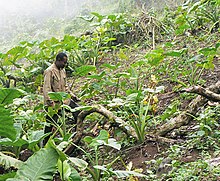
Antaŭ la alveno de agrikulturo, homoj estis ĉasistoj-kolektistoj. Ili manĝis manĝeblajn fruktojn, nuksojn, tigojn, foliojn, guŝojn kaj tuberojn, kadavrumis mortintajn animalojn kaj ĉasadis vivantajn por manĝi.[6] Arbarĝardenado en klarejo de tropika ĝangalo ŝajne estis la unua ekzemplo de agrikulturo; utilaj plantospecioj estis identigitaj kaj kuraĝigitaj por kreski dum nedezireblaj specioj estis forigitaj. Plantobredado pere de selektado de variaĵoj kiu enhavu dezireblajn trajtojn kiaj grandaj fruktoj kaj vigla kreskomaniero sekvis tuje.[7] Kvankam la unuaj pruvoj pri sennaturigo de herboj kiaj tritiko kaj hordeo troviĝis en la Fekunda duonluno en Mezoriento, ŝajne diversaj popoloj ĉirkaŭ la mondo startis kreski rikoltajn produktojn en la periodo de 10,000 a.K. al 7,000 a.K.[8] Vivteniga agrikulturo pluas ĝis nuntempe, ĉar estas multaj ruraj farmistoj en Afriko, Azio, Sudameriko kaj aliloke kiu uzas siajn kampetojn por produkti sufiĉajn manĝaĵojn por siaj familioj, kaj eĉ ajna kromproduktado utilas por akiri aliajn varojn.[9]
Laŭlonge de la registrita historio, riĉuloj povis permesi al si akiri varian dieton kiu inkludu viandon, legomojn kaj fruktojn, sed ĉe malriĉuloj, viando estas luksaĵo kaj la manĝaĵoj kiujn ili manĝas estas tre malvaria, tipe enhavantaj ĉefe iome da bazmanĝaĵoj faritaj el rizo, sekalo, hordeo, tritiko, milio aŭ maizo. La aldono de vegetala materialo havigis iome da varieco al la dieto. La bazmanĝa dieto de Aztekoj en Centrameriko estis el maizo kaj ili kultivis ankaŭ tomatojn, avokadojn, fabojn, kapsikojn, kukurbojn, kaj manĝis ankaŭ semojn de ternuksoj kaj amaranto por suplementi siajn tortiljojn kaj kaĉojn. En la teritorio de la nuna Peruo, la Inkaoj vivtenis sin el maizo en la malaltaj teroj kaj el terpomoj ĉe pli altaj terenoj. Ili uzis ankaŭ semojn el kvinoo, suplementante sian dieton per kapsikoj, tomatoj kaj avokadoj.[10]
En Antikva Ĉinio, rizo estis la bazmanĝa agrikultura produkto en la sudo kaj tritiko en la nordo, el kiuj tiu laste menciita kuiriĝis kiel farĉopastaĵoj, nudeloj kaj patkukoj. Legomoj uzitaj por akompani tiujn estis ignamoj, sojfaboj, faboj, rapoj, ŝalotoj kaj ajloj. La dieto de antikvaj egiptoj estis bazita sur pano, ofte enhavanta sablon kiu difektigis siajn dentojn. Viando estis luksaĵo sed fiŝoj estis pli disponeblaj. Tiuj estis akompanataj de gamo da legomoj kiaj longkukurboj, faboj, lentoj, cepoj, poreoj, ajlo, rafanoj kaj laktukoj.[10]
La ĉefa dieto de la antikvaj grekoj estis pano, kaj tio estis akompanata de kapra fromaĝo, olivoj, figoj, fiŝoj kaj foje viando. La kultivitaj legomoj estis cepoj, ajlo, brasikoj, melonoj kaj lentoj.[11] En Antikva Romo oni faris densan kaĉon el ameltritiko aŭ faboj, akompane de verdaj legomoj sed malmulta viando, kaj fiŝoj ne estis tre aprezataj. Romianoj kultivis grandajn fabojn, pizojn, cepojn kaj refanojn kaj manĝis la foliojn de betoj pli ol ties radikojn.[12]
Kelkaj oftaj legomoj
| Kelkaj oftaj legomoj | |||||
|---|---|---|---|---|---|
| Bildo | Priskribo | Uzataj partoj | Origino | Kultivovarioj | Monda produktado (×106 tunoj, 2012)[13] |
 |
brasiko Brassica oleracea |
folioj, akselaj ŝosoj, tigoj, florŝosoj | Eŭropo | brasiko, ruĝa brasiko, savoja brasiko, krispa brasiko, burĝonbrasiko, tigobrasiko, florbrasiko, brokolo, ĉina brokolo | 70.1 |
 |
rapo Brassica rapa |
tuberoj, folioj | Azio | rapo, napo, ĉina brasiko, pekina brasiko, ĉinia brasiko, verda brasiko | |
 |
rafano Raphanus sativus |
radikoj, folioj, semoguŝoj, semoleo, ŝosoj | Sudorienta Azio | rafano, dajkono, semoguŝaj variaĵoj | |
 |
karoto Daucus carota |
radiktuberoj | Persio | karoto | 36.9[n 1] |
 |
pastinako Pastinaca sativa |
radiktuberoj | Eŭrazio | pastinako | |
 |
ruĝa beto Beta vulgaris |
tuberoj, folioj | Eŭropo, Mezoriento kaj Hindio | ruĝa beto, marbeto, folibeto, sukerbeto | |
 |
laktuko Lactuca sativa |
folioj, tigoj, semoleo | Egipto | laktuko, ĉina laktuko | 24.9 |
 |
faboj Phaseolus vulgaris Phaseolus coccineus Phaseolus lunatus |
guŝoj, semoj | Centra kaj Suda Ameriko | fazeolo, franca fazeolo, ruĝa fazeolo, blanka fazeolo, perua fazeolo | 44.6[n 2] |
 |
faboj Vicia faba |
guŝoj, semoj | Nordafriko Suda kaj sudokcidenta Azio |
fabo | |
 |
pizo Pisum sativum |
guŝoj, semoj, burĝonoj | Mediteranea regiono kaj Mezoriento | ĝardena pizo, ebenpizo, sukerpizo, seka pizo | 28.9[n 2] |
 |
terpomo Solanum tuberosum |
radiktuberoj | Sudameriko | terpomo | 365.4 |
 |
melongeno Solanum melongena |
fruktoj | Suda kaj Orienta Azio | melongeno | 48.4 |
 |
tomato Solanum lycopersicum |
fruktoj | Sudameriko | tomato | 161.8 |
 |
kukumo Cucumis sativus |
fruktoj | Suda Azio | kukumo | 65.1 |
 |
kukurbo Cucurbita spp. |
fruktoj, floroj | Mezameriko | kukurboj, legomkukurbo | 24.6 |
 |
cepo Allium cepa |
bulboj, folioj | Azio | cepo, ŝaloto, askolonio, askalono | 87.2[n 2] |
 |
ajlo Allium sativum |
bulboj | Azio | ajlo | 24.8 |
 |
poreo Allium ampeloprasum |
foliguŝoj | Eŭropo kaj Mezoriento | poreo, elefantajlo | 21.7 |
 |
kapsiko Capsicum annuum |
fruktoj | Norda kaj Suda Ameriko | kapsiko, dolĉa kapsiko | 34.5[n 2] |
 |
spinaco Spinacia oleracea |
folioj | Centra kaj sukokcidenta Azio | spinaco | 21.7 |
 |
ignamo Dioscorea spp. |
tuberoj | Tropika Afriko | ignamo | 59.5 |
 |
Batato Ipomoea batatas |
tuberoj, folioj, burĝonoj | Centra kaj Suda Ameriko | batato | 108.0 |
 |
manioko Manihot esculenta |
tuberoj | Sudameriko | manioko | 269.1 |
Listo de oftaj legomoj
Aziaj legomoj
- liogo laŭ scienca nomo Zingiber mioga
- ĉina brasiko Brassica pekinensis
- pakŝojo Brassica rapa chinensis aŭ ĉina sinapbrasiko
Afrikaj legomoj
Produktado
Kultivado
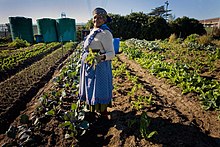
Legomoj estis parto de la homa dieto el ekstermemora tempo. Kelkaj estas bazaj manĝaĵoj sed plej estas akcesoraj kromaĵoj, kiuj aldonas variecon al manĝaĵoj ties unikajn gustojn kaj samtempe, kaj aldonas ankaŭ nutraĵojn necesaj por la sano. Kelkaj legomoj estas plurjaraj sed plej estas unujaraj and biennials, usually harvested within a year of sowing or planting. Whatever system is used for growing crops, cultivation follows a similar pattern; preparation of the soil by loosening it, removing or burying weeds and adding organic manures or fertilisers; sowing seeds or planting young plants; tending the crop while it grows to reduce weed competition, control pests and provide sufficient water; harvesting the crop when it is ready; sorting, storing and marketing the crop or eating it fresh from the ground.[14]
Different soil types suit different crops, but in general in temperate climates, sandy soils dry out fast but warm up quickly in the spring and are suitable for early crops, while heavy clays retain moisture better and are more suitable for late season crops. The growing season can be lengthened by the use of fleece, cloches, plastic mulch, polytunnels and greenhouses.[14] In hotter regions, the production of vegetables is constrained by the climate, especially the pattern of rainfall, while in temperate zones, it is constrained by the temperature and day length.[15]
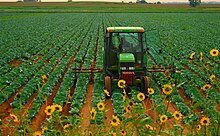
On a domestic scale, the spade, fork and hoe are the tools of choice while on commercial farms a range of mechanical equipment is available. Besides tractors, these include ploughs, harrows, drills, transplanters, cultivators, irrigation equipment and harvesters. New techniques are changing the cultivation procedures involved in growing vegetables with computer monitoring systems, GPS locators and self-steer programmes for driverless machines giving economic benefits.[15]
Harvesting
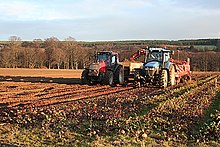
When a vegetable is harvested, it is cut off from its source of water and nourishment. It continues to transpire and loses moisture as it does so, a process most noticeable in the wilting of green leafy crops. Harvesting root vegetables when they are fully mature improves their storage life, but alternatively, these root crops can be left in the ground and harvested over an extended period. The harvesting process should seek to minimise damage and bruising to the crop. Onions and garlic can be dried for a few days in the field and root crops such as potatoes benefit from a short maturation period in warm moist surroundings during which time wounds heal and the skin thickens up and hardens. Before marketing or storage, grading needs to be done to remove damaged goods and select produce according to its quality, size, ripeness and color.[16]
Storage
All vegetables benefit from proper post harvest care. A large proportion of vegetables and perishable foods are lost after harvest during the storage period. These losses may be as high as thirty to fifty percent in developing countries where adequate cold storage facilities are not available. The main causes of loss include spoilage caused by moisture, moulds, micro-organisms and vermin.[17]
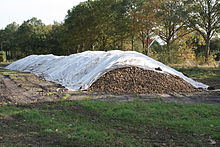
Storage can be short-term or long-term. Most vegetables are perishable and short-term storage for a few days provides flexibility in marketing. During storage, leafy vegetables lose moisture, and the vitamin C in them degrades rapidly. A few products such as potatoes and onions have better keeping qualities and can be sold when higher prices may be available, and by extending the marketing season, a greater total volume of crop can be sold. If refrigerated storage is not available, the priority for most crops is to store high-quality produce, to maintain a high humidity level and to keep the produce in the shade.[16]
Proper post-harvest storage aimed at extending and ensuring shelf life is best effected by efficient cold chain application.[18] Cold storage is particularly useful for vegetables such as cauliflower, eggplant, lettuce, radish, spinach, potatoes and tomatoes, the optimum temperature depending on the type of produce. There are temperature-controlling technologies that do not require the use of electricity such as evaporative cooling.[19] Storage of fruit and vegetables in controlled atmospheres with high levels of carbon dioxide or high oxygen levels can inhibit microbial growth and extend storage life.[20]
The irradiation of vegetables and other agricultural produce by ionizing radiation can be used to preserve it from both microbial infection and insect damage, as well as from physical deterioration. It can extend the storage life of food without noticeably changing its properties.[21]
Preservation
The objective of preserving vegetables is to extend their availability for consumption or marketing purposes. The aim is to harvest the food at its maximum state of palatability and nutritional value, and preserve these qualities for an extended period. The main causes of deterioration in vegetables after they are gathered are the actions of naturally-occurring enzymes and the spoilage caused by micro-organisms.[22] Canning and freezing are the most commonly used techniques, and vegetables preserved by these methods are generally similar in nutritional value to comparable fresh products with regards to carotenoids, vitamin E, minerals and dietary fiber.[23]
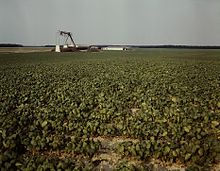
Canning is a process during which the enzymes in vegetables are deactivated and the micro-organisms present killed by heat. The sealed can excludes air from the foodstuff to prevent subsequent deterioration. The lowest necessary heat and the minimum processing time are used in order to prevent the mechanical breakdown of the product and to preserve the flavor as far as is possible. The can is then able to be stored at ambient temperatures for a long period.[22]
Freezing vegetables and maintaining their temperature at below Ŝablono:Convert/°C will prevent their spoilage for a short period, whereas a temperature of Ŝablono:Convert/°C is required for longer-term storage. The enzyme action will merely be inhibited, and blanching of suitably sized prepared vegetables before freezing mitigates this and prevents off-flavors developing. Not all micro-organisms will be killed at these temperatures and after thawing the vegetables should be used promptly because otherwise, any microbes present may proliferate.[24]

Traditionally, sun drying has been used for some products such as tomatoes, mushrooms and beans, spreading the produce on racks and turning the crop at intervals. This method suffers from several disadvantages including lack of control over drying rates, spoilage when drying is slow, contamination by dirt, wetting by rain and attack by rodents, birds and insects. These disadvantages can be alleviated by using solar powered driers.[17] The dried produce must be prevented from reabsorbing moisture during storage.[22]
High levels of both sugar and salt can preserve food by preventing micro-organisms from growing. Green beans can be salted by layering the pods with salt, but this method of preservation is unsuited to most vegetables. Marrows, beetroot, carrot and some other vegetables can be boiled with sugar to create jams.[22] Vinegar is widely used in food preservation; a sufficient concentration of acetic acid prevents the development of destructive micro-organisms, a fact made use of in the preparation of pickles, chutneys and relishes.[22] Fermentation is another method of preserving vegetables for later use. Sauerkraut is made from chopped cabbage and relies on lactic acid bacteria which produce compounds that are inhibitory to the growth of other micro-organisms.[19]
Vidu ankaŭ
- Vegetarismo
- listo de legomoj
- tiglegomo
- fruktlegomo
- radiklegomo
- folilegomo
- florlegomo
- sema legomo
- ŝoslegomoj
- florlegomo
Bildoj
Notoj
- ↑ 1,0 1,1 Vegetable. Dictionary.com. Alirita 2015-03-03.
- ↑ Sinha, Nirmal; Hui, Y.H.; Evranuz, E. Özgül; Siddiq, Muhammad; Ahmed, Jasim (2010). Handbook of Vegetables and Vegetable Processing. John Wiley & Sons. pp. 192, 352. ISBN 978-0-470-95844-5. [1] Alirita la 14an de Decembro 2015.
- ↑ Vainio, Harri kaj Bianchini, Franca. (2003) Fruits And Vegetables. IARC. ISBN 9283230086.
- ↑ Fungi vegetables. Spices & Medicinal Herbs: Classification of vegetables. Alirita 2015-03-24.
- ↑ NIX v. HEDDEN, 149 U.S. 304 (1893). Findlaw.com.
- ↑ Portera, Claire C.; Marlowe, Frank W. (January 2007). “How marginal are forager habitats?”, Journal of Archaeological Science 34 (1), p. 59–68. doi:10.1016/j.jas.2006.03.014.
- ↑ Douglas John McConnell. (1992) The forest-garden farms of Kandy, Sri Lanka. ISBN 978-92-5-102898-8.
- ↑ The Development of Agriculture. National Geographic. Alirita 2015-03-05.
- ↑ Wharton, Clifton R.. (1970) Subsistence Agriculture and Economic Development. Transaction Publishers. ISBN 978-0-202-36935-8.
- ↑ 10,0 10,1 Lambert, Tim A brief history of Food. Alirita 2015-03-04.
- ↑ Apel, Melanie Ann. (2004) Land and Resources in Ancient Greece. Rosen Publishing Group. ISBN 978-0-8239-6769-8.
- ↑ Forbes, Robert James. (1965) Studies in Ancient Technology. Brill Archive.
- ↑ FAOSTAT Query page. Alirita 2015-09-16. Aggregate data: may include official, semi-official or estimated data
- ↑ 14,0 14,1 Brickell, Christopher (ed). (1992) The Royal Horticultural Society Encyclopedia of Gardening. Dorling Kindersley, p. 303–308. ISBN 978-0-86318-979-1.
- ↑ 15,0 15,1 (2007) Introduction to Agricultural Engineering Technology: A Problem Solving Approach. Springer Science & Business Media. ISBN 978-0-387-36915-0.
- ↑ 16,0 16,1 Dixie, Grahame (2005) 8. Post-harvest handling: Storage. Horticultural Marketing. FAO. Alirita 2015-03-21.
- ↑ 17,0 17,1 (2000) Solar Energy: Fundamentals and Applications. Tata McGraw-Hill Education, p. 191. ISBN 978-0-07-463631-2.
- ↑ Kohli, Pawanexh (2008) "Why Cold Chain for Vegetables" in Fruits and Vegetables Post-Harvest Care: The Basics. Crosstree Techno-visors
- ↑ 19,0 19,1 (2010) Handbook of Vegetables and Vegetable Processing. John Wiley & Sons, p. 192, 352. ISBN 978-0-470-95844-5.
- ↑ Thompson, A. Keith. (2010) Controlled Atmosphere Storage of Fruits and Vegetables. CABI. ISBN 978-1-84593-647-1.
- ↑ de Zeeuw, Dick Use of nuclear energy to preserve man's food. International Atomic Energy Agency. Alirita 2015-03-22.
- ↑ 22,0 22,1 22,2 22,3 22,4 (1968) Home preservation of Fruit and Vegetables. Ministry of Agriculture, Fisheries and Food, p. 1–6.
- ↑ Rickman, Joy C. ; Bruhn, Christine M.; Barrett, Diane M. (2007). “Nutritional comparison of fresh, frozen, and canned fruits and vegetables II. Vitamin A and carotenoids, vitamin E, minerals and fiber”, Journal of the Science of Food and Agriculture 87 (7), p. 1185–1196. doi:10.1002/jsfa.2824.
- ↑ (2003) Handbook of Vegetable Preservation and Processing. CRC Press, p. 286–290. ISBN 978-0-203-91291-1.
Eksteraj ligiloj
Ŝablono:EL http://www.uga.edu/nchfp/how/can4_vegetable.html Ŝablono:EL http://www.giantvegenetics.com/Giant_Vegetables/local_links.php Ŝablono:EL http://www.frukt.no
Citaĵa eraro Etikedoj <ref> ekzistas por la grupo nomita "n", sed la responda etikedo <references group="n"/> ne estis trovita; $2



